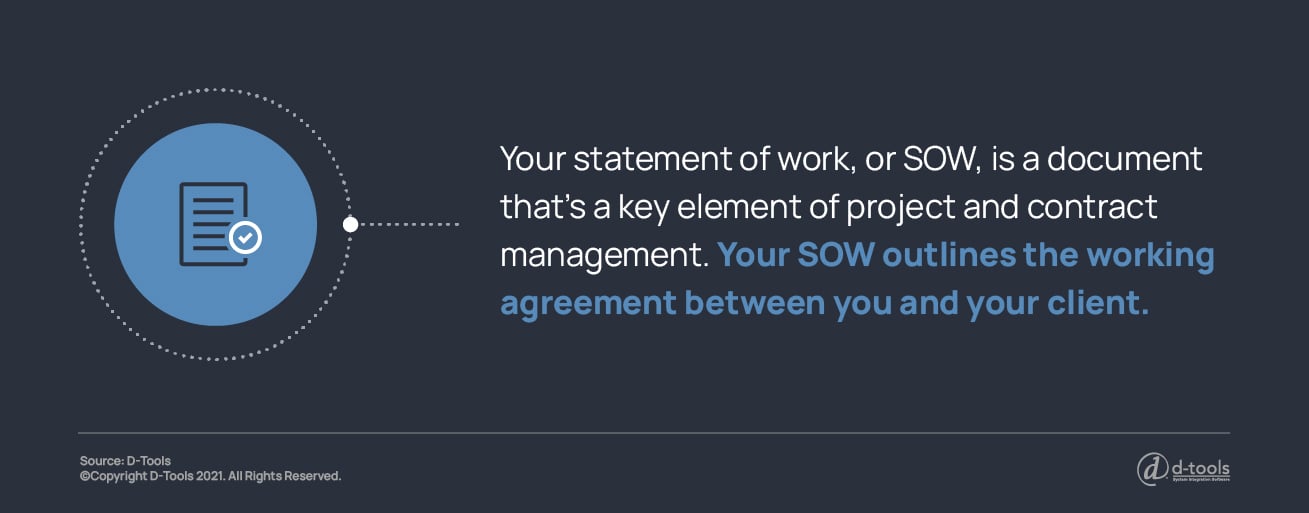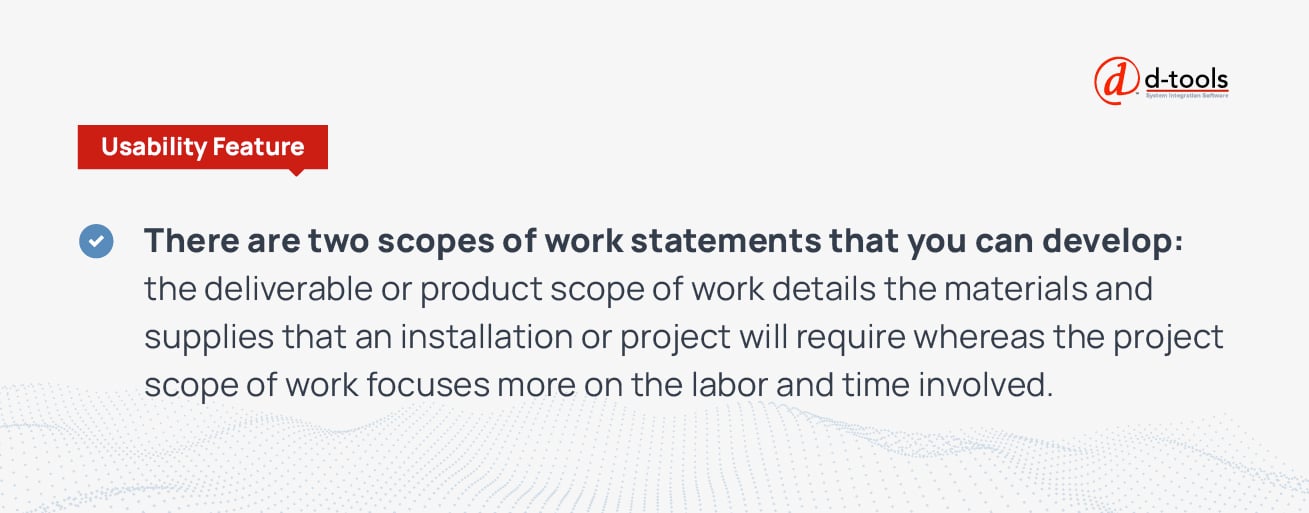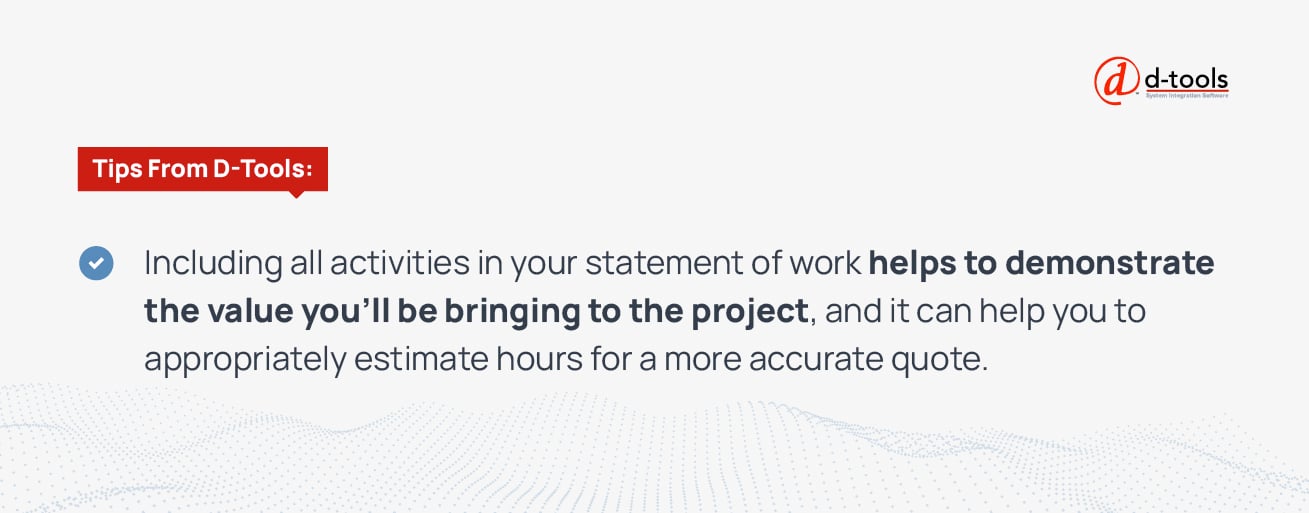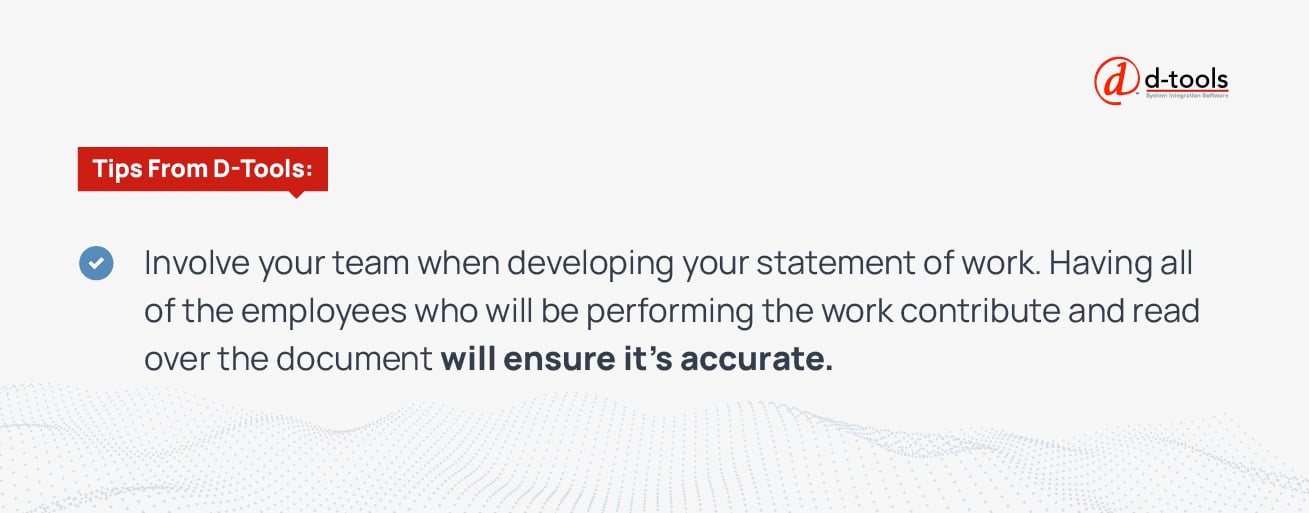Detailed proposals and contracts are key to your AV integration business’ success. These documents contribute to the professionalism of your business, and they can build a potential client’s confidence in your services.
But developing professional contracts and their supporting documents isn’t always easy. To protect your business, you’ll need to become comfortable creating both a statement of work and a scope of work. To accomplish this, you’ll need to understand the differences between these elements and how they relate to your business and each client.
The Difference Between Statement of Work and Scope of Work
Before you start developing these documents, you’ll need to understand the basics of statement of work vs. scope of work.

Your statement of work, or SOW, is a document that’s a key element of project and contract management. Your SOW outlines the working agreement between you and your client.
The SOW can be a large document, and it contains multiple subsections with information on schedules, goals, deliverables, and costs. One of those subsections is your AV scope of work.
The scope of work focuses on details like your project outcomes and the specific types of work that your business will perform to accomplish those outcomes. The scope of work is a key section to include in your statement of work, and understanding the essential elements of both the SOW and scope of work can help you to make an impressive, professional impact on a new or potential client.
Why and How to Develop a Quality AV Scope of Work
Your scope of work outlines a client’s expectations of the type and volume of work that you’ll perform for a specific project or contract. It’s important to make this piece of your SOW highly detailed and specific since it will ensure that you and the client begin the working relationship on the same page.

It can also help protect you from the client expecting an increased project scope, or scope creep. If that project scope grows, but you aren’t compensated for the changes, your overall profits from the project or contract will decline. You may also find that you don’t have enough staff hours dedicated to the project to keep up with the change of scope, and you might face missed deadlines and poor performance as a result. Your scope of work establishes both boundaries for the client and responsibilities for your team; both parties stand to benefit from a well-thought-out document.
To create your scope of work, you’ll need to consider the specific project or contract you’re preparing and what will work best for it, your business, and your client.
Determine the Type of Scope of Work That's Best
There are two scopes of work statements that you can develop. The deliverable or product scope of work details the materials and supplies that an installation or project will require. Developing this scope of work requires an on-site client visit to evaluate the space and identify the AV solutions you will implement. It reads like an inventory list and helps a client to understand exactly what they will be receiving.
These lists are often organized into in-scope lists and out-of-scope lists. The in-scope list would include everything that you’ve budgeted for in the contract cost and everything that would be required for the installation. The out-of-scope list would include optional elements that the client might want to consider purchasing, like an upgraded product, related products like electrical systems, paints, or finishes that could help to complete the project, and more.

In contrast, the project scope of work focuses more on the labor and time involved. You could structure this list in the same way, outlining the activities that are within the project’s scope, and the activities that are out of the project’s scope. It’s important to address common activities like training, troubleshooting, and even site cleanup in this section, so there’s no question about what’s included and what isn’t.
Depending on the project or contract, you may find that providing one or both types of scopes of work is best and clearest.
Start with Client Conversations
When developing your scope of work, you need to account for everything that will be entailed in the AV project or contract. It’s important to have detailed conversations with the client to discuss their goals, the systems they already have in place, and the challenges that they’re facing. If you can identify the solutions that would work best for the client, you’ll have a more concrete plan to work off of when developing your scope of work.
Be sure to also budget time for a site visit if an installation will be involved. Seeing the site in person can help ensure you have accurate measurements. It also allows you to identify potential challenges and start thinking about the solutions you’ll need to develop.
Determine Goals and Your Process
From those client conversations and site visits, you’ll need to determine goals and milestones. These will become a part of your overall statement of work. However, they also inform the type and volume of work that you’ll need to account for in your scope of work.

Start with your client’s broad goals, and then break them down into smaller goals that will contribute to the larger ones. Think about the steps you’ll need to take to accomplish each goal. This is the time to brainstorm potential obstacles you could face, the amount of time it will take to achieve each goal, and how you’ll measure your success.
With those goals in mind, have discussions with the team members who will work on the project or contract. Try to break the work out into stages or different tasks. For example, you might ask your installation technicians to quote the work and time involved in installing a new AV system. Then, you might discuss quotes for training and management with your AV tech specialists. The more familiar a team member is with the work involved, the more accurately you’ll identify the type and volume of work you need to provide.
Write Detailed Goals and Steps
For a project scope of work, you’ll need to take the information that you’ve gained from your team and create a set of detailed goals and steps to include in your statement of work. Be sure to include a target deadline for each step, and then break down the processes involved into individual work activities.

It’s easy to leave important work out of these steps, but that can be problematic. For example, you might not include client conversations or in-house team meetings, but those consume valuable employee time, and they’re times where you’re putting your expertise to use to benefit the client. Include all of these activities in your statement of work. Their inclusion helps demonstrate the value you’ll be bringing to the project, and it can help you to appropriately estimate hours for a more accurate quote.
Get Your Team Involved in Edits
There’s always pressure to get a scope of work done quickly, but take the time to have your team review your drafted scope of work. Last-minute additions or thoughts can help to make the document clearer and more specific, helping to avoid future confusion and questions and protecting your business, in turn.
How to Develop a Quality Statement of Work
Your scope of work is just one section that’s included in your statement of work.
For example, an AV integration statement of work might include the following sections:
- Project or contract objectives
- Scope of work
- Deliverables and goals
- Tasks involved in accomplishing each deliverable or goal
- Work timeline, including deadlines for goal completion, as well as any warranty or maintenance period
- Place of work performance, whether that’s at your office or the client’s site
- Payment costs and terms, whether payment is made by milestone or date
- Deliverable completion criteria
- Signatures for the business and client
Before you start writing your statement of work, you’ll need several client conversations to iron out the details of the project or contract. Just like with your scope of work, you should already have a firm, detailed idea of what work will be entailed, what the project’s goals are, and how you’ll measure success.

Just as you did when writing your scope of work, it’s essential to involve your team when developing your statement of work. The project manager who has been interacting with the client will hold a key role in helping to prepare this document. Again, try to have all of the employees who will be performing the work contribute and read over the document to ensure it’s accurate.
When developing your statement of work, it can be tempting to include extensive detail, but in some cases, less is more. Try to include the detail that you need to ensure the document is clear, but also keep in mind that you don’t want to overwhelm or confuse a client. Offer them time to read the document and ask questions, and then add in any information that the document might lack.
Use the Right AV Project Management Software
The right AV project management software like D-Tools can help to increase your efficiency, improve your accuracy, and make running your business easier, overall. Software can facilitate communication with clients, make for more accurate quoting and inventory management, and make for easier communication with your entire team. Find out which D-Tools product is right for you.


